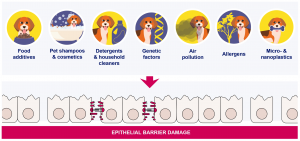Epithelial barrier dysfunction and associated diseases in companion animals: Differences and similarities between
humans and animals and research needs
— Prof. Dr. Cezmi Akdis
DAVOS, SWITZERLAND, October 17, 2024 /EINPresswire.com/ — HOW MODERN LIFE ENDANGERS THE HEALTH OF PETS AND FARM ANIMALS
• Pets share our environment and are regarded by many as beloved family members. Some reside in gardens, while others live within our homes, even sharing our sleeping spaces.
• The modern world has introduced more than 350,000 new chemicals into our daily lives, many of which become part of the life of domestic animals. Cleaning products, food additives and air pollutants have a major impact on the health of animals.
• Pets are more frequently exposed to disinfectants, shampoos and household cleaning materials. They spend much time lying on the floor, walking barefoot on surfaces, and licking themselves. Pets, being closer to ground level, are also more likely to be affected by environmental pollutants such as dust and residues from cleaning products.
• Substances harmful to humans are subsequently banned, however they are often continued to be used in pet products.
• The huge amounts of microplastic entering the lives of all living things in the world, substantially affect animals. Toys, grooming and hygiene products, and food and water bowls have become essential items for many pet owners. Many of these products contain significant amounts of plastic, which can degrade into micro- and nanoplastic particles that pose major risks to the health of animals.
• As observed in humans, packaged and processed modern food of animals contain several additives and emulsifiers that show toxicity to their gastrointestinal system.
• As environmental conditions continue to change, further research is needed into how these changes affect animal health.
• The “Epithelial Barrier Theory” suggests that the growing prevalence of allergic, autoimmune, and other chronic conditions is rooted in increased exposure to agents that compromise the integrity of epithelial barriers. This increased exposure is primarily associated with factors linked to industrialization, urbanization, and the pressures of modern life, including pollution, dietary changes, stress, and widespread use of cleaning products, chemicals and antibiotics. As a result, various harmful substances, including toxins, allergens, and pathogens, can cross these weakened barriers more easily, interacting with the immune system and cause allergic, autoimmune, and neuropsychiatric diseases—all of which have become more prevalent in recent decades.
• The epithelial barrier theory brings attention to the hidden dangers that threaten the health of both humans and animals. Negative impacts on the environment inevitably affect human and animal health, reflecting the core idea behind the One Health concept.
A. Cezmi Akdis and Sena Ardıçlı
Swiss Institute of Allergy and Asthma Research
78 738 82 84
email us here
Visit us on social media:
Facebook
X
LinkedIn
Instagram
Legal Disclaimer:
EIN Presswire provides this news content “as is” without warranty of any kind. We do not accept any responsibility or liability
for the accuracy, content, images, videos, licenses, completeness, legality, or reliability of the information contained in this
article. If you have any complaints or copyright issues related to this article, kindly contact the author above.
![]()







